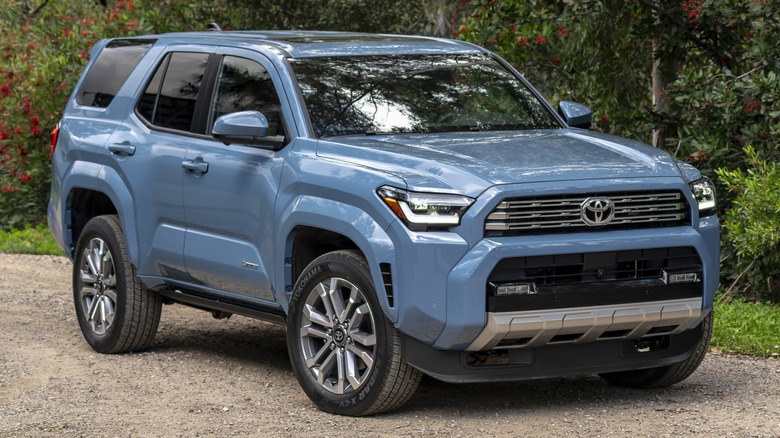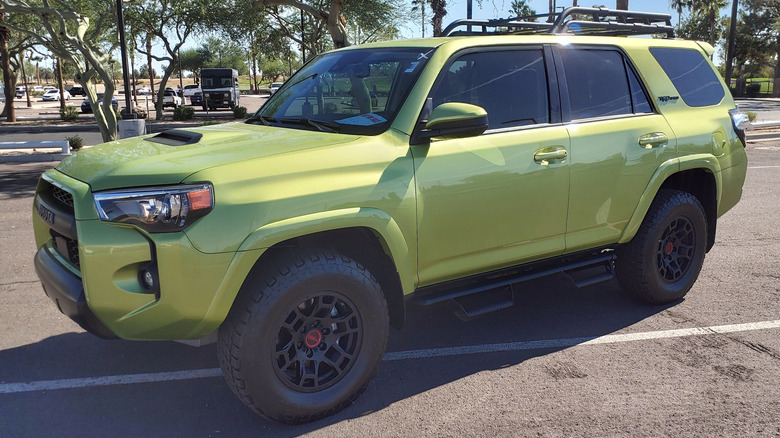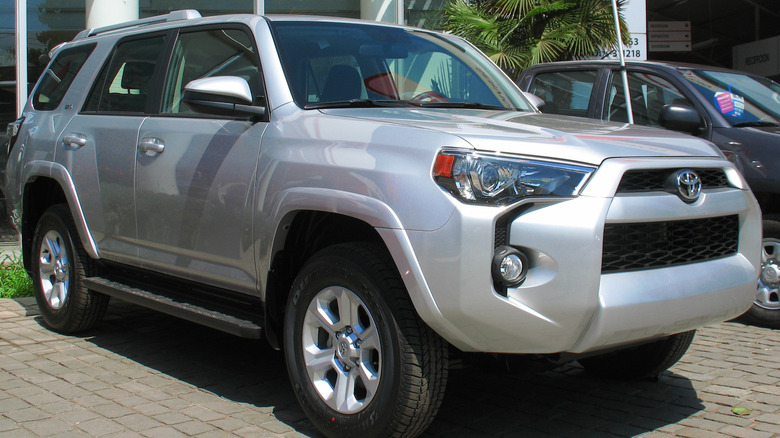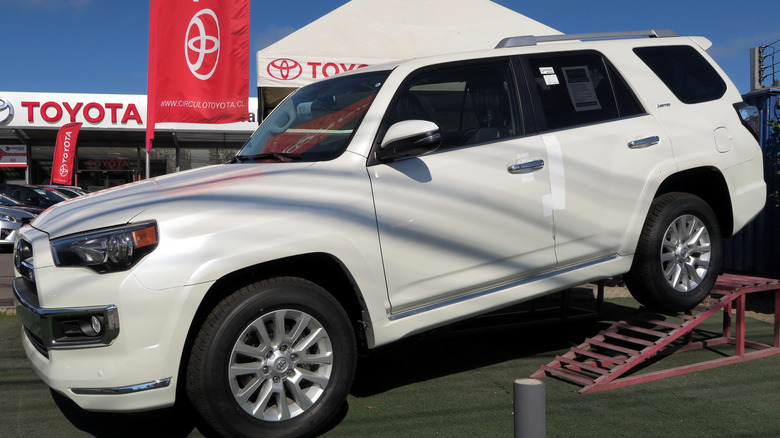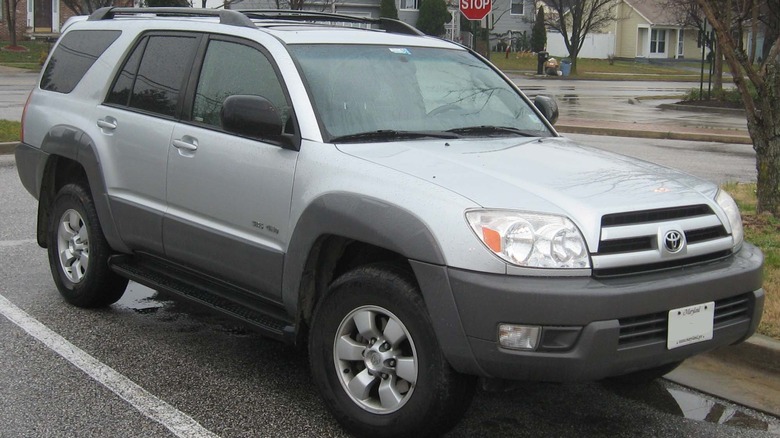4 Common Problems With The Toyota 4Runner (According To Owners)
If there is one thing that Toyota has prided itself on for years, it is the reliability of its vehicles. If Toyota does not rank at the top of the list of the most reliable car brands in the world, then the company's luxury brand, Lexus, is the only one that ranks above it. Considering how much money people spend to purchase a new vehicle, you would hope that these vehicles would be built to last and not give owners constant headaches. Whether it be a small car or a large truck, Toyota has been able to deliver that quality for years. That includes one of the company's larger vehicles, the Toyota 4Runner.
This mid-size SUV has been a staple of Toyota since the 1984 model year, and although the vehicle had a few years of poor sales in the late 2000s, they have fully rebounded to be just as consistently strong as it ever was. With the market now flooded with SUVs, the 4Runner gets to stand in as a stalwart of the form, and you don't get that without reliability. Of course, just because it has this history of reliability does not mean it is a perfect vehicle. The latest 2025 model was the first in a new generation, so there hasn't been quite enough time for drivers to know what could be wrong with the SUV. That being said, throughout the years, drivers have encountered a number of issues that plague certain 4Runner models, and we are going to run through four of the biggest ones in its history.
Faulty airbags in 2022
To speak highly of the Toyota 4Runner, the 2020s have not been a time when drivers have lodged many complaints about the SUV. Despite the fact that this same generation has been around since the 2010 model year, Toyota had clearly ironed out most of the kinks by the time this generation ended in 2024. However, there were still blips here and there of issues in the 2020s, and the most consistent of those would have to be a problem with the 4Runner's airbags in the 2022 model.
According to the National Highway Traffic Safety Administration, the 2022 4Runner was subject to complaints of airbags not properly deploying when they were in a crash. Only six formal complaints with the airbags were made, but considering the overall complaint number is 29, that makes up a sizable percentage. This was a problem that affected both the steering wheel and side curtain airbags, meaning that the passengers were left totally unprotected in these crashes.
Three recalls have been issued for the vehicle, but none of them have been to address this issue. That may mean that these are freak isolated incidents more so than a larger pattern for the 2022 Toyota 4Runner, but if you are in the market for a used model, it is probably better to be safe than sorry and go for the 2021 model, which doesn't have a single air bag complaint made against it.
Electrical issues in the mid-2010s
The mid-2010s had a couple of issues that drivers faced with their Toyota 4Runners. The first of these issues was electrical. However, that is an umbrella term to encompass a number of different problems that the 4Runner faced, particularly when it comes to the model years from 2014 through 2016. For those first two years, a number of drivers had issues with their infotainment systems malfunctioning, either by freezing or randomly rebooting at certain points, according to CarComplaints. Making this even more frustrating is that the drivers on the site never really found a good solution to the problem, nor could they find the true cause.
The 2014 4Runner model had another electrical system issue that it dealt with, completely unrelated to the infotainment system. That would be a malfunction with the electronic door locking for the vehicle. Drivers found that either the doors did not automatically lock when the car was parked, as they should, or they simply couldn't lock the doors without doing it manually.
It is the 2016 model that has the weirdest common complaint of all, though. The most common problem drivers found with this model on CarComplaints was that rats or mice would chew through the car's wires. This seems like it would be a collection of isolated incidents, but the wires used here were soy-based. Because of this, they were particularly attractive to rodents chewing through them. The aim of soy-based wiring is to be more environmentally friendly, but this is just a design flaw that you have to deal with. The mid-2010s Toyota 4Runners just couldn't get their electrical systems in order.
Brake complaints in the 2010s as well
While electrical issues were the primary complaints from drivers from 2014 through 2017, the Toyota 4Runner had quite a large number of complaints about the brakes for the two model years that bookended that stretch, 2013 and 2017. However, these two model years had different brake issues. Starting with 2013, the most common complaint from drivers on CarComplaints was that the brakes would lock up. On the road, drivers were faced with instances of skidding or not being able to properly come to a stop, particularly when it was needed to make a quick stop because of the vehicle in front of them.
Fast forward to the 2017 4Runner, and we have a brake issue where the brakes failed to engage at all. This was the number one complaint submitted by drivers to the NHTSA, making up over one-quarter of the 32 total complaints about the model. For these drivers, the brake pedal would simply sink to the floor of the cabin when pressed. At least in 2013, drivers were having intermittent engagement with the brakes. Here, they were without one of the key pieces for safety.
In the case of both 4Runner models, these problems occurred with relatively low mileage on the SUV, and no recall was made to address these issues, despite them receiving six and five recalls, respectively. So, to fix these problems, it falls on the driver to pay out of pocket for them. Between these brake issues and the electrical ones from the years in between, the mid-2010s were a problematic time for the Toyota 4Runner.
Rusting problems in the early 2000s
While all of the problems mentioned thus far are serious issues that you should look into if you are going to get a used Toyota 4Runner, the actual raw numbers of the people who encounter them are relatively low when compared to other SUVs of its ilk. Where you see a dramatic spike in the number of complaints from drivers is with model years from the early-to-mid-2000s, particularly from 2003 through 2005. That major problem would be excessive rusting and corrosion of the SUV's frame. Complaints from drivers have found this rusting everywhere, from the doors to the undercarriage.
The 2003 4Runner is the model year that CarComplaints deems to be the worst year for the SUV of all because of this problem, even though the 2004 model had more complaints from drivers on the site. Across these three model years, a total of 90 complaints of excessive rusting were made on CarComplaints, easily making it the most common complaint for the 4Runner across its entire lifespan. These rust complaints even go back to the late 1990s, but it's this three-year run where it is most prevalent.
Complaints made to the NHTSA bear this out as well. The 2003 model has a total of 702 complaints from drivers, and over 280 of those have to do with the poor structure of the 4Runner. 2004 had even more structural complaints made to the organization, with over 300 complaints. For 2005, the number came down a bit, but there were still 180. While things like brakes and electrical wires are a pain to replace, overhauling your 4Runner's entire frame isn't something anyone wants to do.
